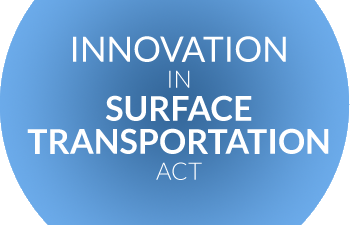The details on a new bill giving locals greater access to their federal dollars
Updated 3/18/15: This bill was reintroduced in the 114th Congress on 3/17/15 in both the House and the Senate with new bill numbers, H.R. 1393 and S.762. It is identical to the version released in 2014 detailed below and this post still serves as an explainer for what the new bill would do. -Ed.
Last week we reported on the introduction of an important bill to expand local access to federal transportation dollars, the Innovation in Surface Transportation Act. Today we want to provide a little more detail about how the proposed new grant program would work.
First, a reminder of the need: Local leaders are the ones who feel the heat when crumbling infrastructure stalls traffic, when workers can’t connect to jobs, streets are unsafe or goods get stuck in congestion. But they lack the access to federal funds that could help them fix those problems and boost their economies, and they have little say in how their state’s federal allocation gets spent.
That’s gotten worse in recent years, not better. When Congress adopted the current federal program, MAP-21, in 2012, it was touted as providing more “local control”. But while states did get more latitude, local communities actually lost access, to the point that only a fraction of the available dollars flow to the cities, towns and suburbs in the metro areas where 85 percent of us live.
The Innovation in Surface Transportation Act would make good on the promise of local control by reserving a small share of transportation dollars in each state to make grants for local projects. (In the 114th Congress, the bill was introduced on 3/17/15 by Senators Wicker (R-MS), Booker (D-NJ), Casey (D-PA) and Murkowski (R-AK) in the Senate, and Representatives Rodney Davis (R-IL), Dina Titus (D-NV) Gregg Harper, (R-MS), Cheri Bustos (D-IL), Dan Lipinski (D-IL) and Matt Cartwright (D-PA) in the House. See updated bill numbers in first paragraph above. -Ed.)
Q: How would projects be selected?
Grants would be awarded based on the strength of the proposal: Will the project result in the highest return on investment? Does it improve safety and reliability? Does the community have their own funds committed to the plan?
Projects would be selected by a statewide jury of local “peers” – other stakeholders who also understand local needs – in collaboration with state DOT representatives. This is critical, because while it ensures DOT involvement, it also makes sure the vision for state progress belongs not just to the bureaucracy but includes regional and local planning organizations, stakeholders from local chambers of commerce, the active transportation community, transit agencies, air quality boards, ports and others.
While each state can tailor their program to suit their needs, the bill outlines a range of selection criteria that should be considered, including improving safety and reliability for all users, promoting multimodal connectivity, improving access to jobs and opportunity, strengthening the overall return on investment, and contributing to a more efficient national multimodal freight network, to name just a few.
Q: Why competitive grants rather than doling out specific amounts to every community by formula?
For one, when projects compete against each other, the sponsoring communities work harder to develop better projects and stretch to make the most of every dollar. And that’s where the “innovation” from the act’s title comes in: Such projects are more likely to solve multiple problems at once and prompt the creation of new partnerships among public and private actors. The innovative, cost-effective and economically important projects will rise to the top, and applicants will learn to sharpen their thinking, planning and inclusiveness around transportation.
Q: What about the handful of states already providing local access to their federal dollars?
H.R. 4726 would allow states that already hold statewide competitions or allocate a majority of federal highway funds to metropolitan or local communities to certify out of the program altogether. If a state is already doing a good job directing money to the best local projects, their efforts would be recognized and rewarded. Additionally, along these same lines, any funds that are currently directed — competitively or otherwise — to metropolitan or local communities would be exempt from inclusion in the new program. These provisions ensure that the bill doesn’t negatively impact states currently providing local control, or require them to re-create the wheel.
For example, read about existing grant programs in Oregon and Pennsylvania.
As we travel the country meeting with local elected, business and civic leaders, we see community after community developing exciting, forward-looking plans to squeeze efficiencies out of road networks expected to move cars, pedestrians, transit riders, bicycles and freight. We hear about unmet repair needs with little help in sight. We see economic opportunities seized upon, or by-passed, based on the ability to invest in a high-quality transportation network.
For them and their constituents, this proposal is the most hopeful sign to come out D.C. in a long time. It could use a lot more co-sponsors to show just how important it is. Urge your representatives to sign on as a cosponsor today by clicking here and sending them a message.
Did you already send your letters and ask your representatives to cosponsor? Then help spread the word! Use the links to share on Twitter and Facebook below, OR, cut and paste the message in the box to send a message to your friends via email.
Shouldn’t the level of government closest to the people have more control over how transportation dollars get spent in their local communities? And shouldn’t they have more access to federal transportation funds?
I think so, and I asked my representatives to cosponsor this bipartisan bill that would give local communities more access to federal transportation funds that they can invest in homegrown transportation plans and projects, and more control over how those dollars get spent.
Will you join me and send a letter? It only takes a moment.
http://action.smartgrowthamerica.org/p/dia/action3/common/public/?action_KEY=19843




















